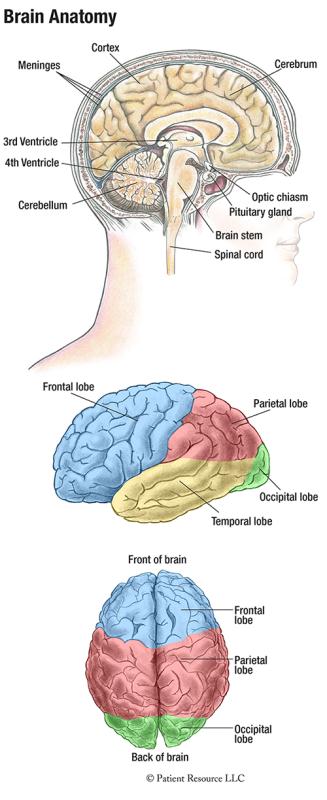Brain Tumors
Overview
Learning you have a brain tumor can be overwhelming. Stop and take a deep breath. You will not go through this alone. You will be surrounded by a skilled health care team of many specialists trained in multiple fields to assist you along the way. Accept help from supportive friends and family as you make necessary choices about your care. You will likely face many decisions ahead, and the more you know about the brain and your diagnosis, the more empowered you’ll feel moving forward.
About the Brain
The brain is an amazingly complex organ that controls the body’s functions and allows us to understand the outside world through intelligence, creativity and memory. The components of the brain include the cerebrum, cerebellum and brain stem, and they each have separate responsibilities.
The cerebrum is the large outer part of the brain. It is made up of two hemispheres (halves) and is further divided into four lobes. Frontal lobes are located behind the forehead. Parietal lobes are located just behind the frontal lobes. Temporal lobes are responsible for memory and hearing; they are located under the frontal and parietal lobes. Occipital lobes are located at the back of the brain and process visual images from your eyes.

The cerebellum lies under the cerebrum at the back part of the brain. It helps coordinate movement and balance.
The brain stem is the lower part of the brain that is connected to the spinal cord. It controls the nerves and muscles that are responsible for involuntary functions, such as breathing, heartbeat, blood pressure and body temperature.
The spinal cord is made up of nerve fibers that are protected by membranes and the bones of the spine. The spinal cord allows the brain to send and receive signals from the rest of the body to control muscles, sensation and feeling.
The cranial nerves emerge directly out of the base of the brain. These nerves allow direct communication to occur between the brain and the face, eyes, ears, tongue, mouth, neck and other areas.
The brain and spinal cord are surrounded by three protective membranes (layers of tissue) collectively known as the meninges. Cerebrospinal fluid, which also protects the central nervous system (CNS), flows through a network of cavities in the brain called ventricles.
Brain Tumors 101
Tumors that originate in the brain or spinal cord are known as primary brain tumors. These are distinctly different from metastatic brain tumors (also known as secondary tumors), which are made up of cancer cells that have spread to the brain from another site.
Primary brain tumors may be considered benign (noncancerous) or malignant (cancerous). Benign tumors are slow growing, appear to have mostly normal cells when examined under a microscope and have distinct borders, meaning they’re less likely to spread into surrounding tissues. However, a benign tumor can be just as dangerous or life-threatening as a malignant tumor if it’s located in or near an area of the brain that controls crucial functions, or if it has a tendency to keep returning.
Malignant brain tumors grow rapidly and are invasive. They may have “roots” that extend into surrounding tissue, making the tumor borders less defined and more difficult to remove surgically. Although brain tumors rarely spread to distant organs, malignant tumors may spread to other areas of the brain or spine through the cerebrospinal fluid.
When doctors refer to brain tumors, they also include the spine and spinal cord. Together, the spine, spinal cord and brain make up the CNS, which controls our personality, senses, movements and other basic bodily functions. The brain and spinal cord are composed of multiple types of tissues and cells, and primary brain tumors can start in any of them.
Meet Your Health Care Team
After learning you have a brain tumor, life changes in many ways. Because it can affect areas of the brain responsible for the physical, emotional and cognitive aspects of your life, you may see a number of specialists.
- Neuropathologists identify brain tumors by studying cells and tissues under a microscope.
- Neuroradiologists create and interpret pictures of the CNS that are produced using forms of radiation, such as X-rays, sound waves or other types of energy.
- Neuro-oncologists diagnose and treat brain tumors.
- Neurosurgeons perform surgery on the brain, spine and other parts of the CNS.
- Neuropsychologists diagnose and treat behavioral and other problems related to the way the brain works. These may include problems with social interactions, ability to control emotions and behaviors, and cognitive abilities, such as thinking, learning, remembering and problem solving. These problems may be caused by the tumor or its treatment.
- Nurse practitioners oversee patient care management.
- Nurse navigators identify education and support resources for you and your family.
- Social workers may help you and your caregiver with various tasks, such as finding services or working with insurance companies.
- Rehabilitation specialists may be involved with your care depending on your specific diagnosis. These specialists can provide physical, occupational or speech therapy.
Take advantage of your support system. Rely on the help of your family, friends and your medical team to help you become comfortable making decisions regarding your treatment and care. For additional support and organizations to help with your specific needs, explore the resources here.



